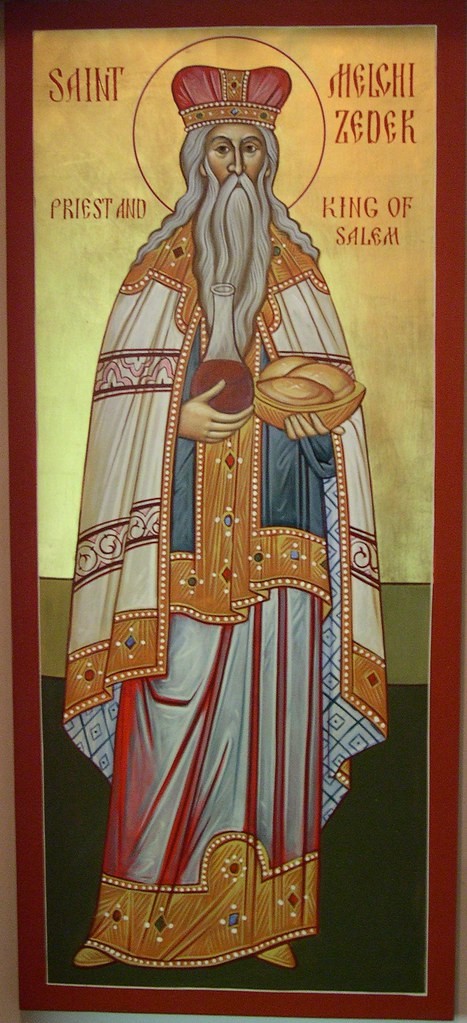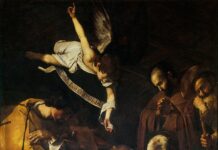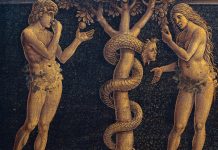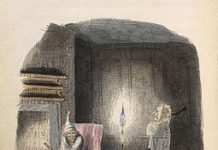Have you ever wondered about the identity of that mysterious figure in the book of Genesis named Melchizedek, the King of Salem who offers a sacrifice of bread and wine for Abraham after his successful rescue of his nephew Lot from his captors?[1] Or have you ever wondered about the significance of Psalm 110:4, where King David writes, “[y]ou are a priest for ever, after the order of Melchiz′edek.”[2]? Lastly — perhaps a new question for many — have you every wondered about the relation of Melchizedek and his priesthood to Saint Joseph? If you have ever wondered these questions, this article will provide an answer to them.
First, who is Melchizedek? Why does this man styled as the “King of Salem” and whose name means “King of Righteousness”[3] only appear once in the book of Genesis for a brief encounter with Abraham, never to appear again? Well, the reader may be surprised to know that Melchizedek does appear more than once in the book of Genesis; in fact, he appears earlier in the book of Genesis, albeit under a different name. For Melchizedek actually makes his first appearance not as the righteous priest-king of Salem, but rather as the firstborn son of Noah the Patriarch, whose name is Shem.[4]
How do we know that Melchizedek is the same person as Shem? We know this most recently from the consensus of modern Catholic biblical scholars such as Scott Hahn,[5] John Bergsma,[6] Brant Pitre,[7] and Steven Smith.[8] Moreover, the ancient Jewish tradition almost unanimously identified Shem and Melchizedek as the same person;[9] for both the Targums — which were the ancient translations of the Jewish Scriptures into Aramaic, the language that the Jews spoke during the time of Jesus — and the later rabbinic tradition both regularly and consistently identify Shem and Melchizedek as being the same person.[10] Further, the Christian tradition — which is made up of the Fathers of the Church and of the Scholastic Theologians — was nearly just as unanimous as the Jewish tradition was on this point of the identity of Shem-Melchizedek.[11] Among the various Church Fathers that identified Shem with Melchizedek,[12] we have Saint Jerome who supported the thesis that Shem is Melchizedek,[13] and also Saint Ephrem the Syrian who also accepted this position, writing the following:
This Melchizedek is Shem, who became a king due to his greatness; he was the head of fourteen nations. In addition, “he was a priest.” He received [his priesthood] from Noah, his father, through the rites of succession. Shem lived not only to the time of Abraham, as Scripture says, but even to [the time of] Jacob and Esau.[14]
Further, the eminent Scholastic Theologian Saint Thomas Aquinas also accepted the tradition that Shem is Melchizedek in his commentary on Saint Paul’s Letter to the Hebrews. Here, the Angelic Doctor writes that:
For so the Scripture names [Melchizedek] in Genesis (Gen 14:18), where his history, which the Apostle supposes here, is recorded. According to a Gloss, the Hebrews say that this was Shem, the first-born of Noah, and when Abraham obtained the victory, he was 390 or 309 years old and met Abraham, his nephew.[15]
Lastly, the Glossa Ordinaria — which was the medieval compendium or collection of the various glosses or commentaries of the Church Fathers on Scripture — also affirms the identification of Shem with Melchizedek, writing that “the Hebrews say this Melchizedek was Shem son of Noah, who lived until Isaac.”[16] The Christian tradition’s possible unanimity or consensus on this topic is a particularly compelling point about the identity of Shem-Melchizedek, given the unanimity of the Fathers.
Given that Melchizedek and Shem are one and the same person, it is necessary to move to a consideration of the meaning of Psalm 110:4. Psalm 110:4 makes reference to the priesthood of Melchizedek, which, as the Glossa Ordinaria tells us, was a natural priesthood in the Old Testament which was passed on from father to firstborn son.[19] Moreover, this priesthood of Melchizedek actually begins with Adam, who was “the archetypal high priest of Creation,”[20] and is passed on to all of the patriarchs of the Old Testament, from Noah, to Shem-Melchizedek, to Abraham, to Isaac, all the way down to Aaron and Moses.[21]
To answer the final question, how does the identity of Shem-Melchizedek and Psalm 110:4 relate to Saint Joseph? Remember Shem-Melchizedek’s title “King of Salem”? Well, it turns out that Salem is the older form of the name Jeru-salem or Jerusalem, and so Melchizedek is actually the King of Jerusalem.[22] Later on in the history of Israel, David becomes King of Jerusalem, and hence by inheriting the kingship of Jerusalem from Melchizedek, he also inherits the priesthood of Jerusalem, which is the Priesthood of Melchizedek.[23] Further, 2 Samuel 8:18 tells us that “[King] David’s sons were priests,”[24] meaning that when King David became King of Jerusalem, not only did he himself enter the Melchizedekian succession of the priesthood of Melchizedek, but King David also passed on this Melchizedekian priesthood to all of his male descendants[25] — including Saint Joseph. For how does the Angel Gabriel greet Saint Joseph in the gospel of Saint Matthew?[26] “Joseph, son of David” is the greeting of the Angel Gabriel to Saint Joseph,[27] which means that Saint Joseph is a son or male descendant of King David. Moreover, Saint Matthew traces Jesus’ genealogy through Saint Joseph all the way to King David,[28] proving once again that Saint Joseph is a male descendant of King David. Therefore, since 2 Samuel 8:18 tells us that all of the male descendants of King David are priests, and since Saint Matthew’s gospel tells us that Saint Joseph is a son or male descendant of King David, this means that Saint Joseph also inherits the priesthood of Melchizedek, that Saint Joseph is a priest according to the order of Melchizedek, and that The Eternal High Priest Jesus Christ can claim that he is a priest according to the order of Melchizedek because his most proximate ancestor — viz., his virginal father Saint Joseph — is the final link in the chain of the Melchizedekian priestly succession.
Thus, knowing all of this, one can finally make sense of a certain supernatural phenomenon that occurred at one of the most significant historical events of human history, viz., the Miracle of the Sun at Fatima. For at Fatima, there was a vision of Saint Joseph holding the Christ Child, and together they blessed the world, making the Sign of the Cross with their hands.[29] Moreover, according to Saint Thomas Aquinas’ Principle of Operation, a thing performs certain actions because it is a certain type of thing, which is to say that a thing only acts in a certain way insofar as it is something.[30] Therefore, since Saint Joseph in the Miracle of the Sun at Fatima is performing a priestly action, viz., blessing the world by making the Sign of the Cross, then this means that Saint Joseph is a priest. Thus, since Saint Joseph is a priest is according to the order of Melchizedek, this helps Catholics make sense as to why Saint Joseph is blessing the world along with Jesus; namely, because Saint Joseph exercises the priesthood of Melchizedek along with his Divine Son the Eternal High Priest Jesus Christ, and therefore — according to Psalm 110:4 — Saint Joseph is a priest in aeternum, and hence exercises his Melchizedekian priesthood with the Eternal High Priest Jesus Christ — in aeternum.[31]
[1] Genesis 14:1-20 (Revised Standard Version Catholic Edition).
[2] Psalm 110:4 (Revised Standard Version Catholic Edition).
[3] Hebrews 7:1-3 (Revised Standard Version Catholic Edition).
[4] Genesis 6:10 (Revised Standard Version Catholic Edition), emphasis added: “And Noah had three sons, Shem, Ham, and Japheth.”
[5] Scott W. Hahn, Kinship by Covenant: A Canonical Approach to the Fulfillment of God’s Saving Promises (New Haven & London: Yale University Press, 2009), 134-135, 299-300.
[6] John Bergsma, Jesus and the Old Testament Roots of the Priesthood (Steubenville, Ohio: Emmaus Road Publishing, 2021), 33, 104-105; John Bergsma and Brant Pitre, A Catholic Introduction to the Bible: The Old Testament (San Francisco: Ignatius Press, 2018), 153-154.
[7] Ibid.
[8] Steven C. Smith, The House of the Lord: A Catholic Biblical Theology of God’s Temple Prescence in the Old and New Testaments (Steubenville: Franciscan University Press, 2017), 99.
[9] Bergsma, Jesus and the Old Testament Roots of the Priesthood, 33, 104-105. Bergsma and Pitre, A Catholic Introduction to the Bible, 153: “[L]ater Jewish tradition…almost unanimously identified Melchizedek as Shem.”
[10] Hahn, Kinship by Covenant, 299; Bergsma, Jesus and the Old Testament Roots of the Priesthood, 33. Bergsma and Pitre, A Catholic Introduction to the Bible, 153-154.
[11] Ibid., 153: “[L]ater Jewish and Christian tradition almost unanimously identified Melchizedek as Shem.”
[12] Ibid., 153-154.
[13] Smith, The House of the Lord, 66n16.
[14] Ephrem the Syrian, Commentary on Genesis II.2, quoted in Bergsma and Pitre, A Catholic Introduction to the Bible, 154, emphasis added.
[15] Saint Thomas Aquinas, Commentary on the Letter of Saint Paul to the Hebrews, trans. F. R. Larcher, O.P., ed. J. Mortensen and E. Alarcon, (Lander: The Aquinas Institute for the Study of Sacred Doctrine, 2012), C. 7, L. 1, n. 327, emphasis added https://aquinas.cc/la/en/~Heb.C7.L1.n327: “Sic enim nominat [Melchisedech] Scriptura, Gen. XIV, v. 18, ubi habetur historia, quam Apostolus hic supponit. Et secundum Glossam, Hebraei dicunt ipsum fuisse Sem primogenitum Noe, et tunc quando Abraham habuit victoriam, erat annorum 390, alias 309. Et occurrit Abrahae nepoti suo.”
[16] Bergsma and Pitre, A Catholic Introduction to the Bible, 154.
[17] Pope Blessed Pius IX, Tuas Libenter, Libreria Editrice Vaticana, December 21, 1863, https://www.vatican.va/content/pius-ix/la/documents/epistola-tuas-libenter-21-decembris-1863.html; Fr. Chad Ripperger, Ph.D., The Consensus of the Fathers and Theologians (Sensus Traditionis Press, 2020), 1-35; Fr. Chad Ripperger, Ph.D., Magisterial Authority (Sensus Traditionis Press, 2014), 27-32; Fr. Chad Ripperger, The Principle of the Integral Good (Sensus Traditionis Press, 2018), 15n12; Heinrich Denzinger, Compendium of Creeds, Definitions, and Declarations on Matters of Faith and Morals, 43rd ed., ed. Peter Hünermann, Robert Fastiggi, and Anne Englund Nash (San Francisco: Ignatius Press, 2012), Gregory IX, Ab Aegyptiis (Denz. 824/442), Sixtus IV, Romani Pontificis provida, (Denz. 1407), (Denz. 370/173), (Denz. 396/199), (Denz. 399/200b), (Denz. 1600/843a), (Denz. 1692/905), (Denz. 2855/1672).
[18] For the different theological grades or notes and their related theological censures, see Dr. Ludwig Ott, Fundamentals of Catholic Dogma, ed. James Canon Bastible, D.D., trans. Patrick Lynch, Ph.D. (Charlotte: TAN Books, 1974), 9-10.
[19] Bergsma and Pitre, A Catholic Introduction to the Bible, 154; Bergsma, Jesus and the Old Testament Roots of the Priesthood, 8-64, 104-105; Smith, The House of the Lord, 96.
[20] Ibid., 40-41, 75-78, 81-95; Bergsma, Jesus and the Old Testament Roots of the Priesthood, 8-28, 104-105; Bergsma and Pitre, A Catholic Introduction to the Bible, 103 and 154; Hahn, Kinship by Covenant, 279.
[21] Bergsma and Pitre, A Catholic Introduction to the Bible, 154; Bergsma, Jesus and the Old Testament Roots of the Priesthood, 8-57, 104-105; Smith, The House of the Lord, 95-97.
[22] Ibid., 98; Bergsma and Pitre, A Catholic Introduction to the Bible, 153-154; Bergsma, Jesus and the Old Testament Roots of the Priesthood, 32, 103-104.
[23] Ibid., 57-64, 104-105; Smith, The House of the Lord, 100.
[24] 2 Samuel 8:18 (Revised Standard Version Catholic Edition), emphasis added.
[25] Bergsma, Jesus and the Old Testament Roots of the Priesthood, 62 and 104.
[26] According to Saint Thomas Aquinas, it was the Angel Gabriel that appeared to Saint Joseph. See Saint Thomas Aquinas, Commentary on the Gospel of Matthew, Chapters 1-12, trans. Jeremy Holmes and Beth Mortensen, ed. The Aquinas Institute (Lander: The Aquinas Institute for the Study of Sacred Doctrine, 2013), C. 1, L. 4, n. 120, https://aquinas.cc/la/en/~Matt.C1.L4.n120, emphasis added: “Angelus Domini: nihil enim melius potuit excusare, quam ille qui conscius erat virginitatis servatae. Unde ille idem angelus qui missus est ad Mariam, Luc. I, 26, creditur missus ad Ioseph, Ps. XXXIII, 8: immittet angelus Domini in circuitu timentium eum, scilicet Mariae, et Ioseph, ut ipsam liberaret ab infamia, et Ioseph in perturbatione non dimitteret.”
[27] Matthew 1:20 (Revised Standard Version Catholic Edition).
[28] Ibid., 1:6-16.
[29] Mark I. Miravalle, STD, Meet Your Spiritual Father: A Brief Introduction to St. Joseph (Lighthouse Catholic Media and Marian Press, 2015), 88-89; Donald H. Calloway, MIC, Consecration to St. Joseph: The Wonders of Our Spiritual Father (Stockbridge: Marian Press, 2020), 195; Msgr. Joseph A Cirrincione with Thomas A. Nelson, St. Joseph, Fatima and Fatherhood: Reflections on the “Miracle of the Sun” (Charlotte: TAN, 1989), 3; Taylor R. Marshall, Infiltration: The Plot to Destroy the Church from Within (Manchester: Crisis Publications, 2019), 69; Msgr. Arthur B. Calkins, “St. Joseph in the Church since 1917 – Msgr. Calkins, Fatima Centennial Conference – October 7, 2017,” YouTube, October 10, 2018, 00:00-2:02, https://www.youtube.com/watch?v=2rAJaFIly2I; “St. Joseph: Patron of the Triumph of Mary’s Immaculate Heart,” YouTube, September 20, 2015, 17:35-17:59 https://www.youtube.com/watch?v=eu-DVXd7PtU; “Lenten Mission on St. Joseph: Patron of An Age of Peace,” YouTube, May 21, 2020, 13:24-14:06, https://www.youtube.com/watch?v=r9jdgBpI17A.
[30] Fr. Chad Ripperger, FSSP, Ph.D., The Metaphysics of Evolution: Evolutionary Theory in Light of First Principles (Norderstedt: Books on Demand), 34-35 and 43; Saint Thomas Aquinas, Summa Theologiae, trans. Fr. Laurence Shapcote, O.P., ed. John Mortensen and Enrique Alarcon (Lander: The Aquinas Institute for the Study of Sacred Doctrine, 2012), I, q. 89, a. 1, co., https://aquinas.cc/la/en/~ST.I: “[M]odus operandi uniuscuiusque rei sequitur modum essendi ipsius.”
[31] Bergsma, Jesus and the Old Testament Roots of the Priesthood, 100-105.











